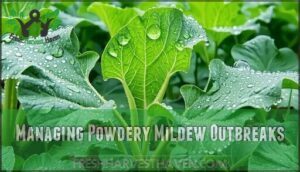This site is supported by our readers. We may earn a commission, at no cost to you, if you purchase through links.

This fungal disease loves crowded, humid conditions, so don’t let your tomatoes become a cozy neighborhood for spores. Water at soil level, not on leaves, and choose morning watering to let plants dry quickly.
Resistant varieties like ‘Mountain Fresh Plus’ or ‘Iron Lady’ give you a head start. Weekly neem oil or milk sprays (yes, milk works!) create an inhospitable environment for fungal growth.
Proper garden hygiene and tool sanitization complete your defense strategy for healthier harvests.
Table Of Contents
- Key Takeaways
- Powdery Mildew Basics
- Preventing Powdery Mildew
- Natural Control Methods
- Resistant Tomato Varieties
- Managing Powdery Mildew Outbreaks
- Frequently Asked Questions (FAQs)
- How to prevent powdery mildew in tomatoes?
- How do you keep powdery mildew from coming back?
- When should you put baking soda around tomato plants?
- What is the best method for controlling powdery mildew?
- How to prevent powdery mildew on tomatoes?
- What is the natural enemy of powdery mildew?
- What is the best way to prevent powdery mildew?
- Can I spray soapy water on my tomato plants?
- Does baking soda prevent powdery mildew?
- How does powdery mildew affect soil health?
- Conclusion
Key Takeaways
- Space your tomato plants 2-4 feet apart, prune lower leaves weekly, and stake them to maintain airflow and prevent fungal growth.
- Water at the soil level in the morning to keep leaves dry and minimize humidity, which powdery mildew thrives on.
- Use natural remedies like neem oil or milk sprays to protect your plants without harsh chemicals.
- Choose resistant tomato varieties, like ‘Iron Lady’ or ‘Mountain Fresh Plus,’ and keep garden tools sanitized to stop spores from spreading.
Powdery Mildew Basics
You’ve probably seen those white, dusty patches on your tomato leaves and wondered if you accidentally spilled flour in the garden.
That mysterious white dust on your tomatoes isn’t flour—it’s powdery mildew plotting against your harvest.
This fungal menace, called powdery mildew, thrives in warm, humid conditions between 60-80°F and can spread quickly through your entire tomato patch if you don’t catch it early.
What is Powdery Mildew
Powdery mildew is one sneaky fungal disease that’ll sneak up on your tomato plants when you least expect it. This troublemaker appears as white powdery growth on tomato leaves, creating that telltale dusty coating that looks like someone sprinkled flour everywhere.
Fungal identification starts with spotting pale yellow patches that transform into powdery white spots. Fungal spores travel through air currents, making spore transmission incredibly easy between plants. Roses are also susceptible, requiring preventative garden hygiene to minimize risk.
Here’s what you’re dealing with:
- Disease symptoms include twisted, yellowing leaves that eventually die
- Mildew symptoms progress from yellow patches to white, powdery coating
- Plant impact reduces photosynthesis and weakens overall plant health
- Mildew types affecting tomatoes include three specific fungi species
Early detection saves your harvest!
Crops Vulnerable to Powdery Mildew
Many crops fall victim to this persistent fungal foe. Host Plant Range extends beyond tomatoes to cucumbers, squash, peppers, eggplants, beans, grapes, and roses.
Disease Severity varies substantially—some plants shrug it off while others suffer major damage.
Powdery mildew tomatoes aren’t your garden’s only concern. This tomato plant fungus loves weak, stressed plants in poorly managed soil.
Regional Variations affect which crops get hit hardest in your area.
Smart tomato disease prevention starts with choosing mildew resistant tomatoes and understanding Environmental Impact.
Genetic Resistance varies widely between varieties. Preventing tomato diseases means recognizing that good airflow and proper spacing protect your entire garden, not just tomatoes.
Ideal Powdery Mildew Conditions
Three key factors create the perfect storm for powdery mildew tomatoes: warmth, humidity, and stagnant air.
Warmth, humidity, and stagnant air—the unholy trinity that turns your tomato paradise into a powdery nightmare.
This sneaky fungus thrives in Temperature Range between 60-80°F, making spring and fall prime seasons for trouble.
Unlike other plant diseases, it doesn’t need wet leaves—high Humidity Levels around your plants provide enough moisture for spores to germinate and spread.
Poor Airflow creates the ideal breeding ground, trapping moisture around foliage even when Leaf Wetness isn’t visible.
Your tomatoes become sitting ducks when planted too close together or in shady spots with limited Sunlight Exposure.
Watch for these warning signs:
- Dense plantings with crowded foliage
- Shaded garden areas with minimal sun
- High humidity after cool, wet nights
- Stagnant airflow between plants
- Overwatered soil creating excess moisture
Prevention beats treatment every time—focus on sunlight and proper spacing.
Preventing Powdery Mildew
You can stop powdery mildew before it starts by creating conditions that make your tomato plants hostile to fungal growth.
The key lies in managing airflow, spacing, and cleanliness—three simple practices that’ll keep those white, powdery spots from turning your beautiful tomatoes into a science experiment gone wrong, which can be prevented by managing airflow.
Pruning for Airflow
Through strategic pruning techniques, you’ll create the airflow benefits your tomatoes desperately need to fight powdery mildew. Think of good airflow like opening windows in a stuffy room—it keeps everything fresh and disease-free.
Smart tomato pruning starts with leaf removal from the bottom up. Those lower leaves touching soil are fungal highways, so snip them off regularly. Air circulation improves dramatically when you reduce plant density around each stem.
Here’s your five-step pruning game plan:
- Remove yellowing lower leaves weekly to eliminate fungal launching pads
- Trim suckers between main stems and branches for better airflow
- Cut crossing branches that create dense, humid pockets
- Thin overcrowded foliage from plant centers for sunlight exposure
- Stake plants upward to open up growing space naturally
Regular pruning creates the ventilation system your tomatoes need. Understanding how mildew spreads is essential for effective prevention. You’ll notice healthier plants and fewer disease problems almost immediately.
Proper Spacing Techniques
After pruning your tomato plants, you’ll need to master plant spacing to complete your powdery mildew defense strategy.
Give each tomato plant its breathing room by maintaining an Optimal Distance of 2-4 feet between plants. Your Row Spacing should stretch 4 feet apart, creating highways for Air Circulation to flow freely through your garden.
This thoughtful layout supports Vertical Growth while maximizing Sunlight Exposure for every leaf. Crowded plants become humidity traps that invite fungal problems, but proper spacing lets airflow whisk away moisture before mildew takes hold.
Consider optimal plant distances to maximize growth. Think of it as creating personal space bubbles for your tomatoes. Each plant gets adequate sunlight, while moving air prevents the stagnant conditions that powdery mildew craves for establishing itself.
Sanitizing Garden Tools
Clean garden tools act like your first line of defense against powdery mildew spores that love to hitchhike between plants. Tool disinfection isn’t just good practice—it’s essential for preventing cross-contamination in your tomato garden.
Clean tools, healthy garden. Regarding powdery mildew, your pruners shouldn’t spread the problem.
Here’s your sanitization game plan:
- Alcohol vs. Bleach: Use 70% rubbing alcohol for quick tool sterilization between plants, or mix 1 part bleach with 9 parts water for deep cleaning methods.
- Tool Cleaning Frequency: Sanitize after each infected plant and daily during outbreaks.
- Safe Storage Practices: Store clean, dry garden tools in ventilated areas after sharpening sanitized tools.
Remember, consistent tool disinfection keeps spores from spreading—your tomatoes will thank you!
Natural Control Methods
You don’t need expensive chemicals to fight powdery mildew on your tomatoes—your kitchen pantry holds some surprisingly effective weapons.
Simple ingredients like milk, baking soda, and neem oil can create powerful natural barriers that stop this fungal troublemaker before it takes over your plants.
Neem Oil Treatment
You’ve already established good spacing and airflow practices, but now let’s arm your tomatoes with neem oil treatment—your organic arsenal against powdery mildew. This golden extract from neem tree seeds packs serious fungicidal power while keeping your garden chemical-free.
Mix 2 tablespoons of neem oil concentrate with 1 gallon of water for effective mildew prevention. The proper mixing ratios matter—too weak won’t work, too strong burns leaves. Apply every 7-14 days during cooler morning or evening hours as your application frequency schedule.
- Coat both leaf surfaces completely, paying extra attention to undersides where spores love to hide. Safety precautions include avoiding applications above 90°F and skipping stressed plants.
You can find various neem products online. The neem oil benefits extend beyond fungal control—it also repels aphids, whiteflies, and other tomato pests. This natural remedy gives you dual protection in one spray, making organic tomato care simpler. Alternative oils like rosemary or peppermint work too, but neem remains the gold standard.
Milk Spray Prevention
While neem oil offers excellent protection, milk spray prevention provides an even simpler approach to homemade mildew control. This natural tomato remedy transforms ordinary kitchen staples into powerful organic tomato care.
The perfect Milk Spray Ratio combines 1 part milk with 9 parts water—full-fat milk works best since proteins create stronger antiseptic barriers. Application Frequency matters: spray every 7-10 days throughout the growing season for consistent mildew prevention.
Milk Type Matters substantially. Whole milk contains more proteins than skim varieties, boosting your solution’s effectiveness. Focus on thorough Spray Coverage Tips—coat both leaf surfaces completely, paying extra attention to undersides where spores hide.
Consider these Alternative Additives for enhanced protection:
- Add 1 teaspoon dish soap per gallon for better leaf adhesion
- Include 1 tablespoon baking soda for extra fungicidal power
- Mix in neem oil for dual-action pest control
- Try buttermilk for higher protein content
Morning application lets sunlight activate milk’s natural fungicidal properties, creating an invisible shield that keeps your tomatoes healthy without harsh chemicals.
Baking Soda Spray
Baking soda spray delivers impressive spray effectiveness against powdery mildew.
Mix proper mixing ratios: 1 tablespoon baking soda, ½ teaspoon liquid soap per gallon of water. Apply weekly for ideal application frequency.
This homemade mildew control works as preventative baking soda treatment. Test plant sensitivity first on small areas.
Among natural remedies, this gentle fungicide alternative protects your tomatoes safely. This method leverages alkalinity for fungus control.
Resistant Tomato Varieties
You can save yourself hours of frustration by choosing tomato varieties that naturally resist powdery mildew from the start.
Smart gardeners know that selecting resistant cultivars like Geronimo, Climstar F1, or Frederik F1 cuts your workload in half while keeping your plants healthier throughout the growing season, which is a complete concept in gardening that can greatly benefit your plants.
Choosing Resistant Cultivars
Smart gardeners know that cultivar selection is your first line of defense against powdery mildew. Instead of battling this fungal foe later, you can outsmart it from day one by choosing resistant tomato varieties.
Modern plant breeding has delivered mildew-resistant tomatoes with impressive hybrid vigor. These resistant cultivars don’t just survive—they thrive while their susceptible cousins struggle with mildew infection.
Top performers for your garden include:
- Celebrity – A reliable determinate variety that’s practically bulletproof against powdery mildew
- Mt. Fresh – Combines excellent disease resistance with outstanding flavor profiles
- Sun Start – Early-season producer that laughs in the face of fungal pressure
When selecting resistant varieties, consider your regional suitability too. What works in humid Florida might differ from dry Colorado conditions. Some varieties even offer Verticillium wilt resistance for added protection. While grafting options and seed saving have their place, starting with proven resistant cultivars gives you the biggest bang for your gardening buck.
Environmental Modifications
Beyond choosing resistant varieties, you’ll need environmental modifications to create conditions hostile to powdery mildew.
Practice crop rotation annually to disrupt fungal lifecycles and improve soil health.
Switch your watering practices to drip irrigation—this reduces humidity around plants while maintaining efficient moisture delivery.
Control plant density through strategic spacing that balances sunlight exposure without creating stagnant microclimates.
Effective weed control eliminates competition and improves airflow optimization.
These changes work together, transforming your garden into an environment where good airflow naturally prevents fungal problems.
Sunlight and Air Circulation
Optimal sunlight and air circulation work together as your garden’s defense system against powdery mildew.
When tomatoes get proper sunlight exposure, fungal spores struggle to establish themselves on dry, warm leaves.
Good airflow prevents the stagnant, humid conditions that mildew loves:
- Position plants for 6-8 hours of direct sunlight daily
- Use strategic pruning techniques to open dense foliage
- Consider plant spacing of 24-36 inches between tomatoes
This prevention strategy creates an environment where mildew simply can’t thrive.
Managing Powdery Mildew Outbreaks
When powdery mildew strikes your tomatoes despite your best prevention efforts, you’ll need to act quickly to save your harvest.
Spotting those telltale white, powdery patches early and knowing exactly how to respond can mean the difference between losing a few leaves and watching your entire crop struggle.
Identifying Early Symptoms
Your detective work starts with initial spotting those sneaky pale yellow patches on lower leaves. Leaf discoloration appears first, then transforms into that signature white, chalky powdery residue within days.
Distinguishing mildews matters—powdery mildew creates dry, dusty coatings while downy mildew produces fuzzy patches underneath leaves.
Early symptoms include brittle leaf texture and growth stunting as photosynthesis decreases. Tomato leaf problems escalate quickly, so check both leaf surfaces during weekly inspections.
Fungal infections tomatoes spread rapidly through airborne spores.
Identifying early symptoms gives you the upper hand—catch those first yellow spots before they become full-blown white powder explosions across your plants.
Removing Infected Plants
Once you’ve spotted those white patches, quick action stops powdery mildew from taking over your garden. Removing infected plants requires careful handling to prevent spreading this stubborn fungal disease.
Never add diseased material to your compost pile—those spores survive and multiply. Instead, use proper disposal methods like sealed bags or controlled burning for effective disease management.
- Picture yourself as a plant surgeon, carefully snipping infected leaves with sanitized shears
- Imagine sealing contaminated debris in thick plastic bags, trapping sneaky spores forever
- Visualize your healthy tomatoes breathing easier after their sick neighbors are gone
- Think of protecting your soil health by keeping fungal spores away from future crops
Safe handling protects your entire garden from this persistent threat.
Using Fungicides and Biofungicides
When powdery mildew strikes despite your best efforts, fungicides and biofungicides become your reliable backup plan.
Start fungicide application when plants reach 10-12 inches tall, spraying every 7-14 days throughout the growing season.
Systemic fungicides like sulfur or copper offer conventional protection, while biofungicide efficacy comes from beneficial bacteria in products like Serenade.
Organic options include neem oil and horticultural oils.
Consider fungicides for mildew for effective treatment.
Practice resistance management by alternating between different fungicide groups—never rely on just one type.
Always spray leaf tops and undersides for complete coverage.
Frequently Asked Questions (FAQs)
How to prevent powdery mildew in tomatoes?
Coincidentally, spacing your tomatoes 2-4 feet apart prevents that dreaded white fungal coating.
You’ll also want to water at soil level, prune lower leaves regularly, and choose resistant varieties for best results.
How do you keep powdery mildew from coming back?
Space your plants well, prune dense foliage, and water at the soil level.
Rotate crops yearly, clean garden tools, and choose resistant varieties.
Apply natural sprays like neem oil or baking soda regularly.
When should you put baking soda around tomato plants?
Think of baking soda as a protective shield; spray a mix (1 tbsp soda, ½ tsp soap, 1 gallon water) weekly during humid spells, early morning, before mildew appears. Cover all leaves evenly.
What is the best method for controlling powdery mildew?
The best way to tackle powdery mildew is prevention.
Give plants space, prune dense areas, and water soil, not leaves.
Weekly sprays of diluted neem oil or milk work wonders, and sunlight’s your biggest ally!
How to prevent powdery mildew on tomatoes?
Don’t underestimate airflow—it’s key!
Space tomato plants at least 2 feet apart, stake or prune them for sunlight, and water at the base.
Avoid wet leaves and try weekly milk or baking soda sprays.
What is the natural enemy of powdery mildew?
Beneficial fungi like Ampelomyces quisqualis are natural enemies of powdery mildew.
They parasitize powdery mildew spores, reducing its spread.
Introducing these fungi is like releasing a microscopic cleanup crew directly onto the problem area!
What is the best way to prevent powdery mildew?
Space plants 2-4 feet apart, prune dense foliage for airflow, and water at the base to avoid wet leaves.
Plant in sunny spots and rotate crops yearly.
Try resistant varieties to outsmart mildew’s tricks!
Can I spray soapy water on my tomato plants?
Did you know soapy water can kill soft-bodied pests like aphids?
For powdery mildew, soap sprays may help indirectly but aren’t a reliable cure.
Use them sparingly, avoiding harsh soaps that harm plants.
Does baking soda prevent powdery mildew?
Baking soda can help prevent powdery mildew by creating an alkaline surface on leaves, making it harder for the fungus to thrive.
Mix 1 tablespoon baking soda, ½ teaspoon soap, and 1 gallon of water.
How does powdery mildew affect soil health?
Oddly enough, powdery mildew doesn’t harm soil directly.
The fungus only thrives on living plant tissues, not in dirt.
But infected plants dropping leaves can add fungal spores to the soil, risking future outbreaks if unmanaged.
Conclusion
Preventing powdery mildew in homegrown tomatoes requires smart planning, consistent care, and a few handy tricks.
Space your plants, prune for airflow, and water early at soil level for healthier growth.
Choose resistant varieties, like ‘Iron Lady,’ and try natural remedies, such as neem oil or milk sprays, to stop fungi in their tracks.
Don’t forget garden hygiene—clean tools matter! With these strategies, you’ll enjoy vibrant, mildew-free tomatoes, leaving your garden—and taste buds—thriving.
- https://www.epicgardening.com/powdery-mildew-tomatoes/
- https://ipm.ucanr.edu/home-and-landscape/powdery-mildew-on-vegetables/pest-notes/
- https://www.gardendesign.com/how-to/powdery-mildew.html
- https://katiespring.com/tomato-lessons-powdery-mildew-aphids-and-why-you-should-ignore-instagram/
- https://bsppjournals.onlinelibrary.wiley.com/doi/full/10.1046/j.1464-6722.2001.00084.x












